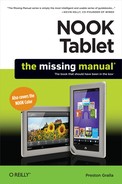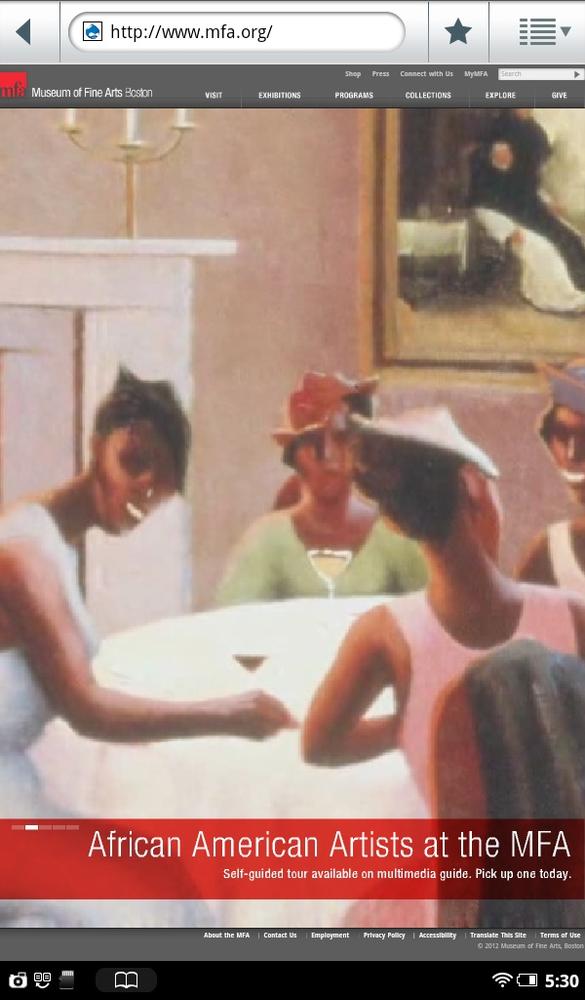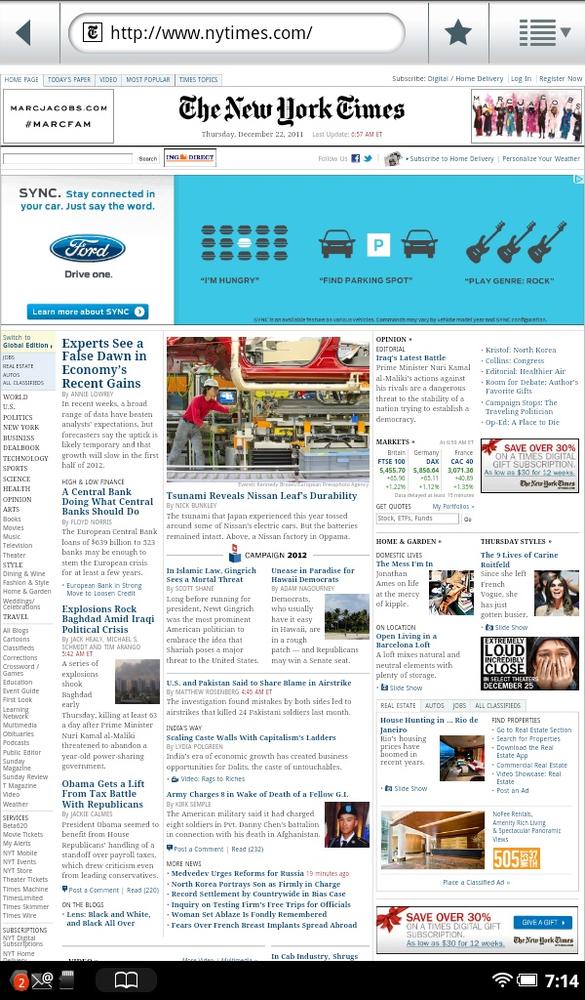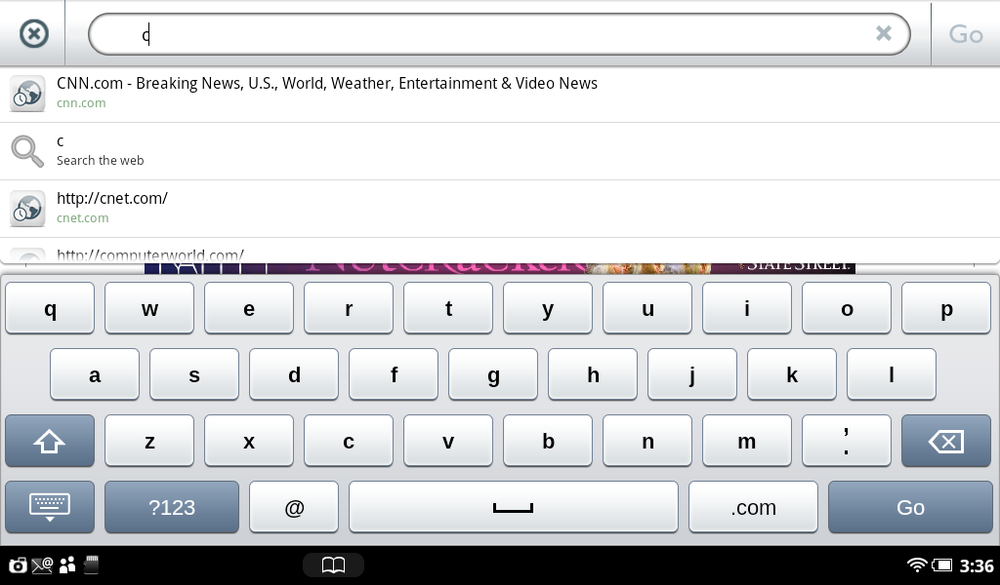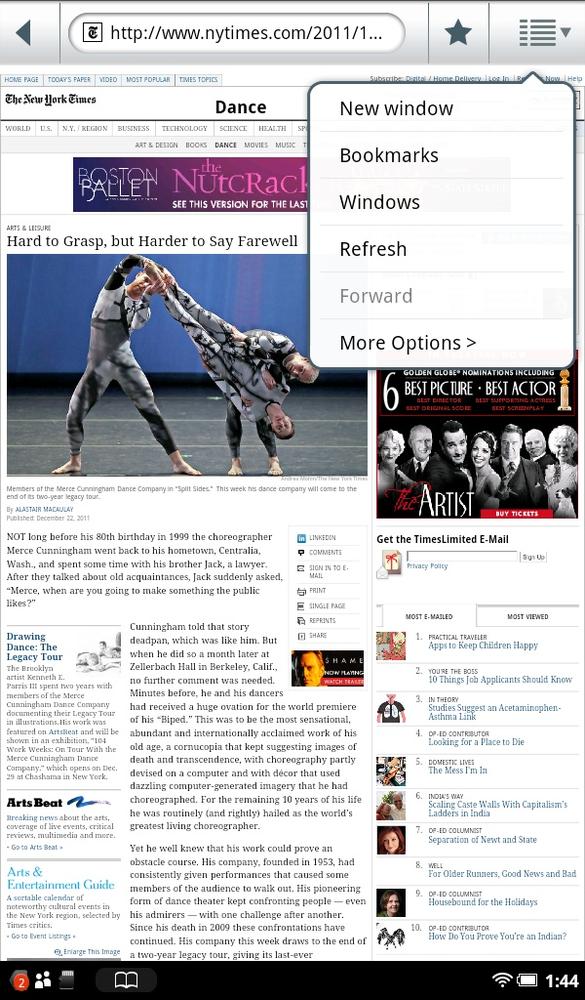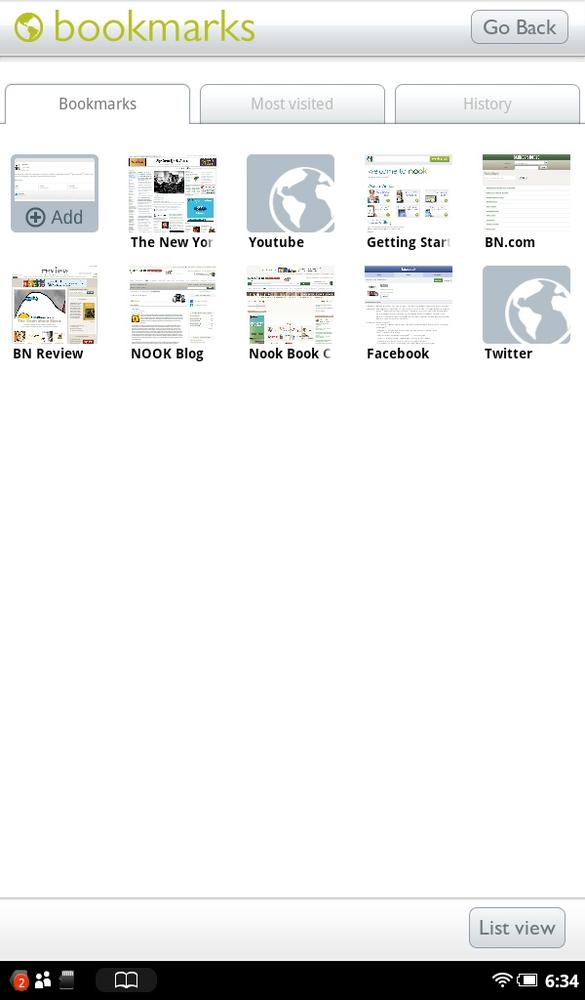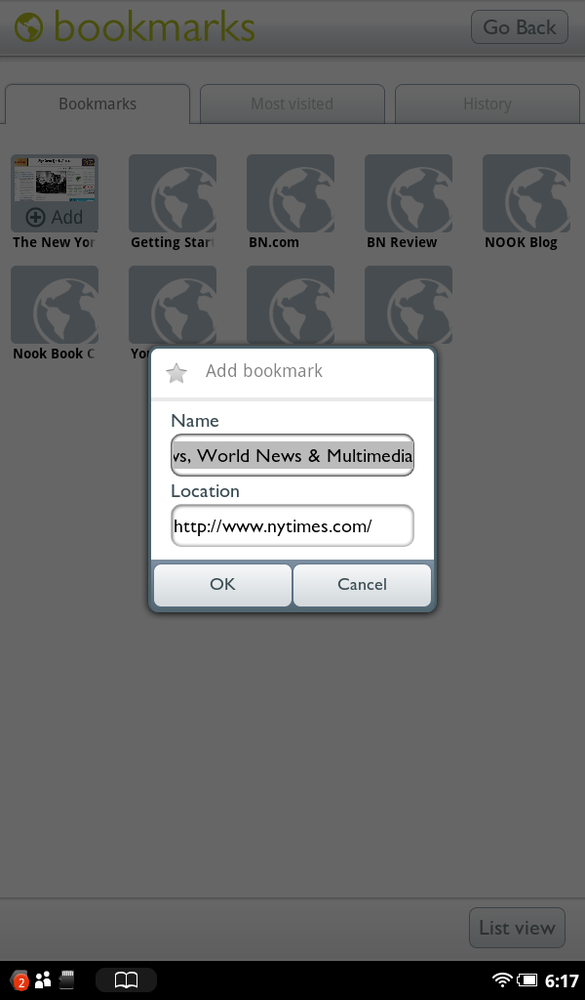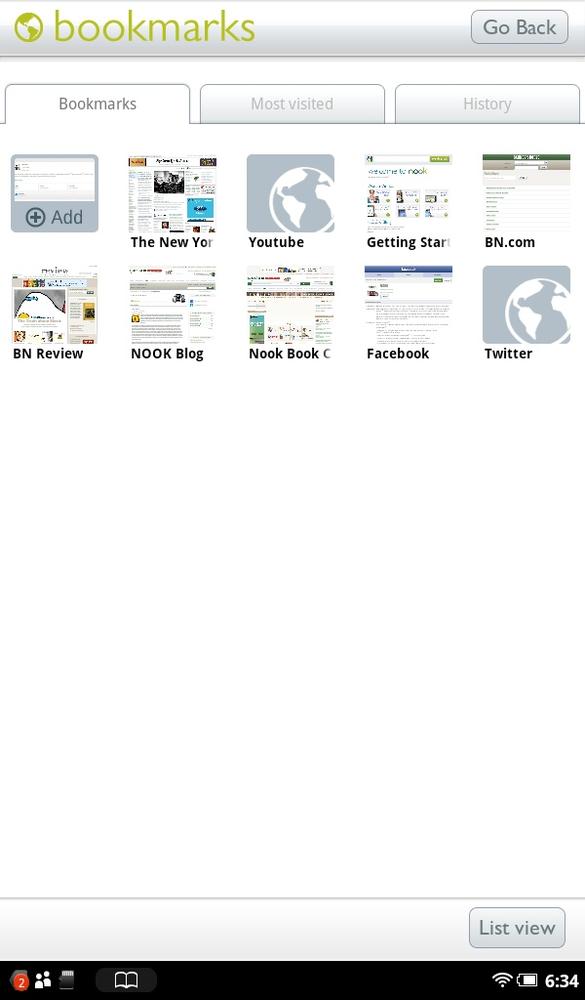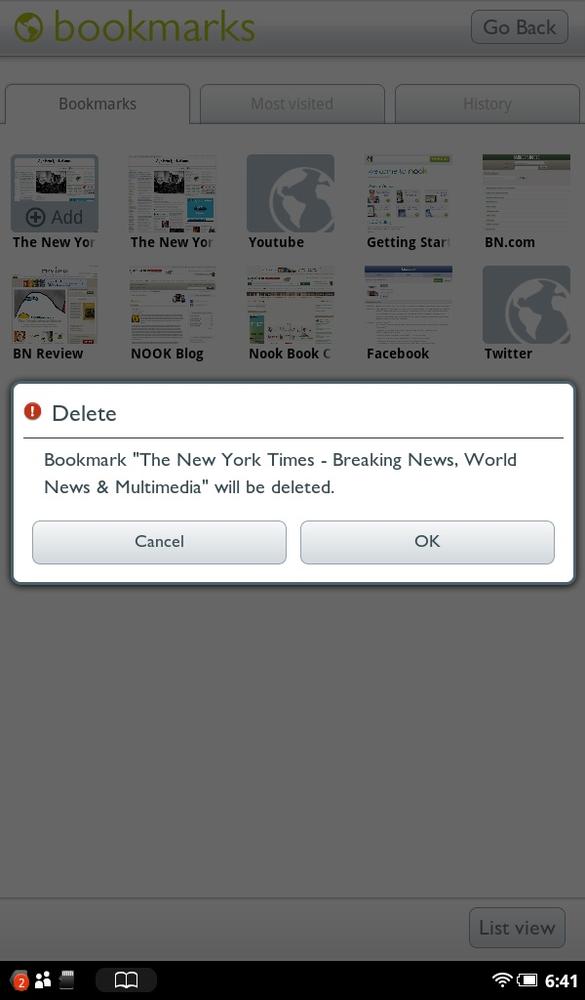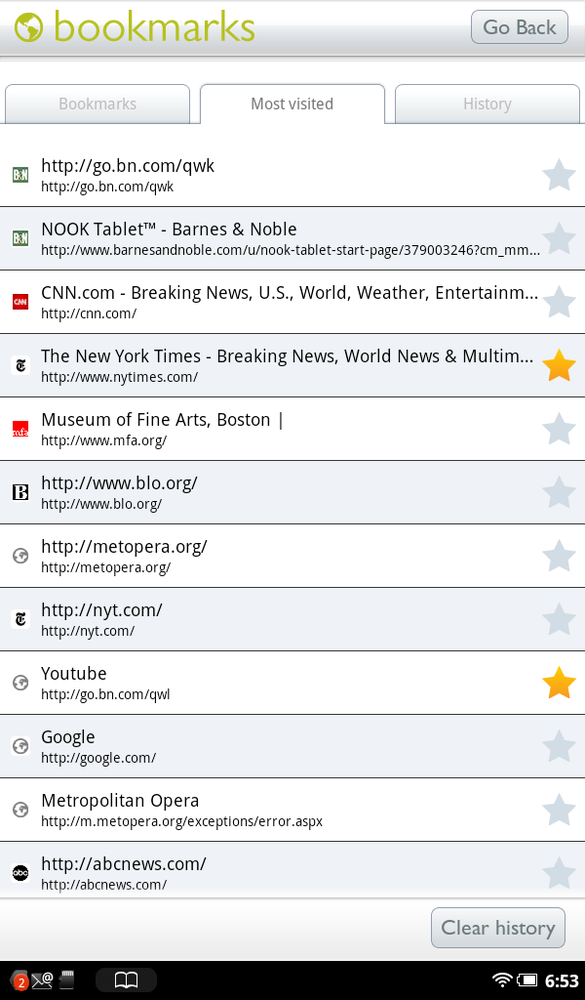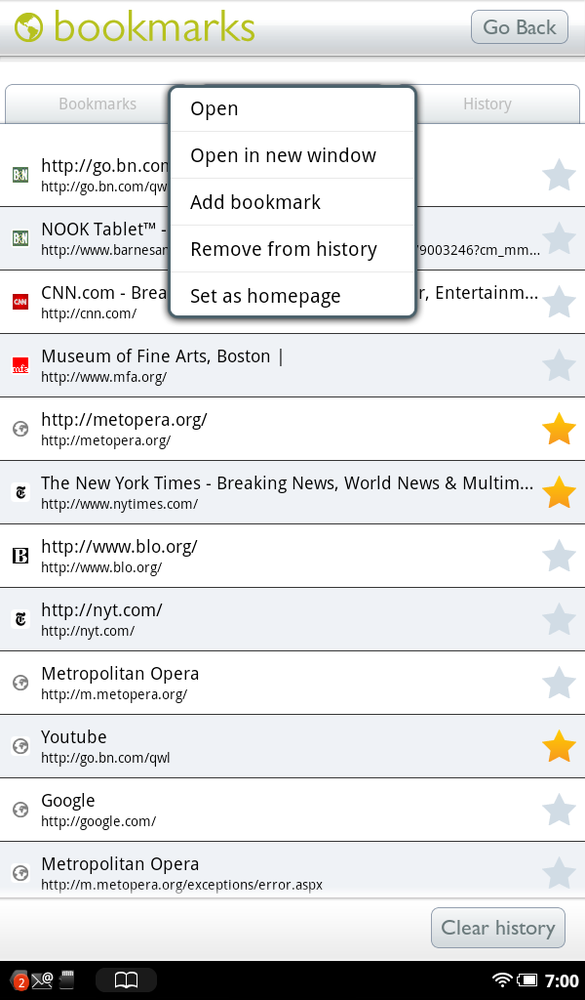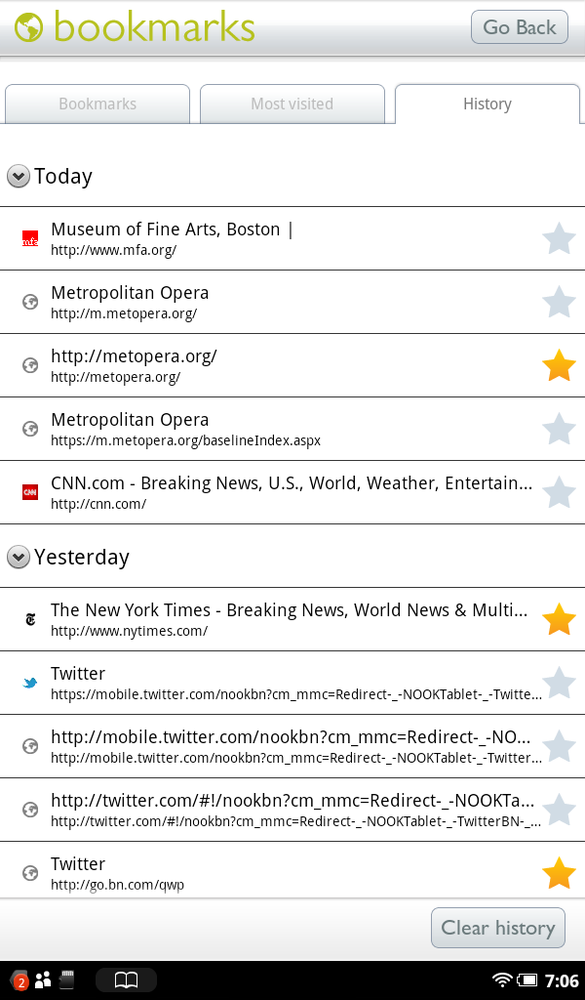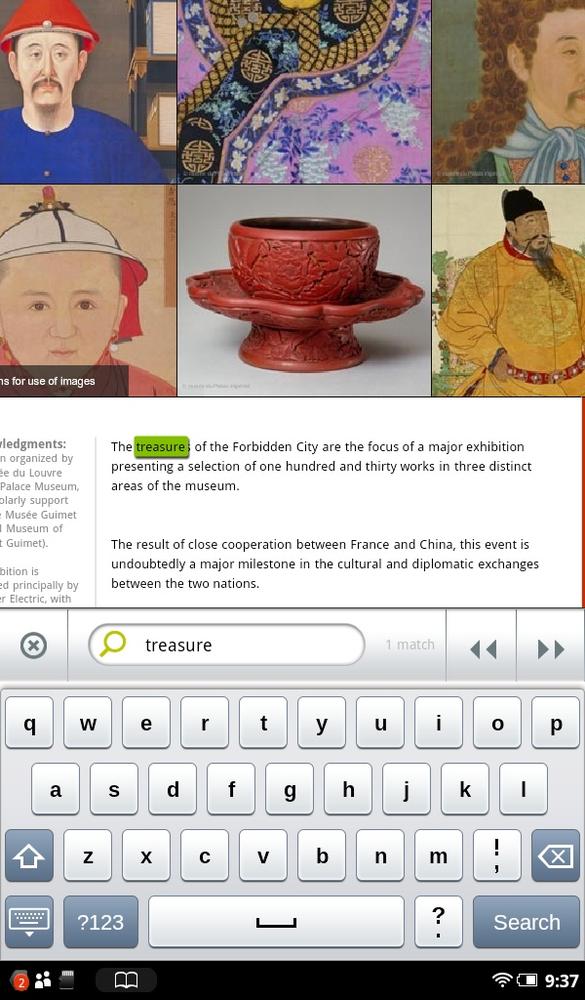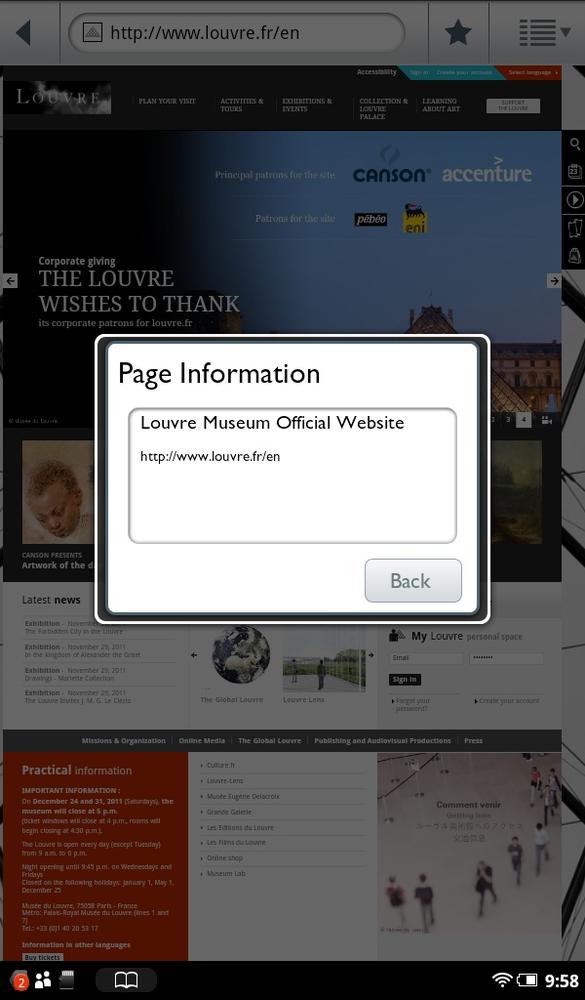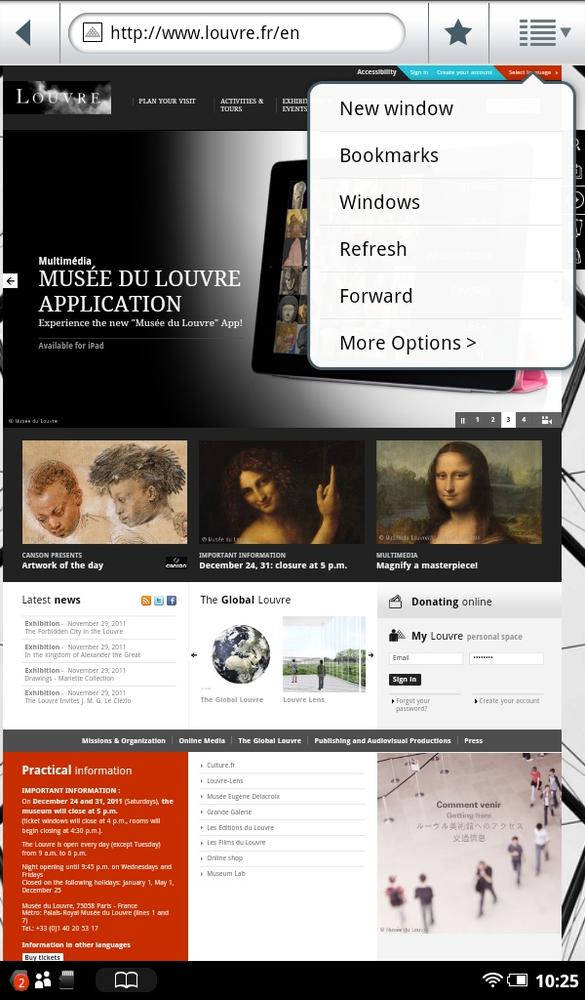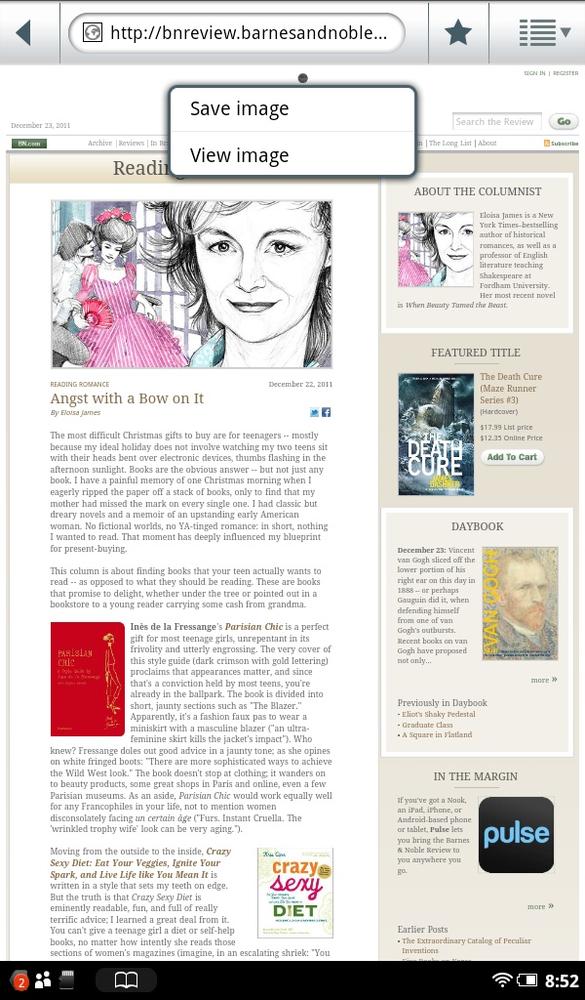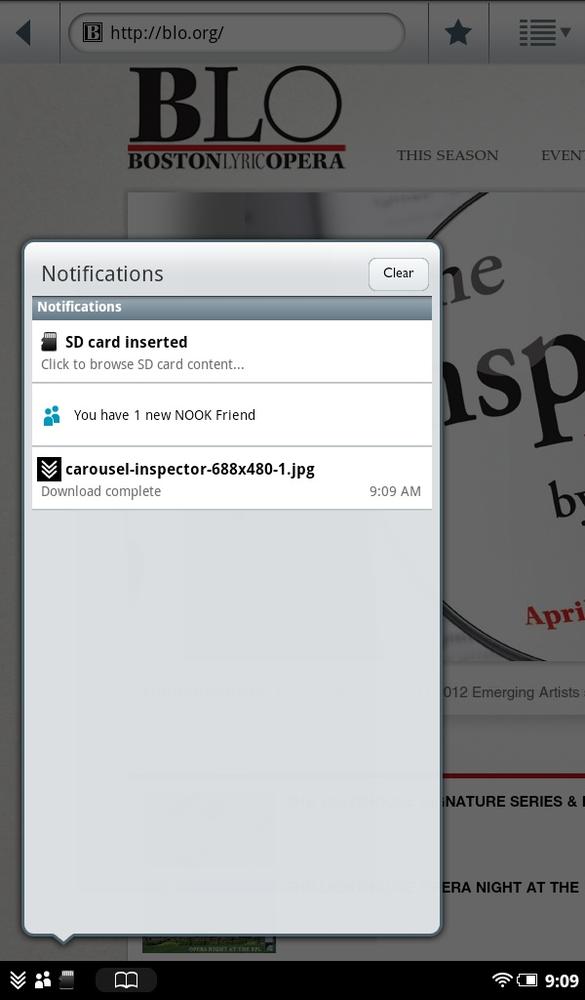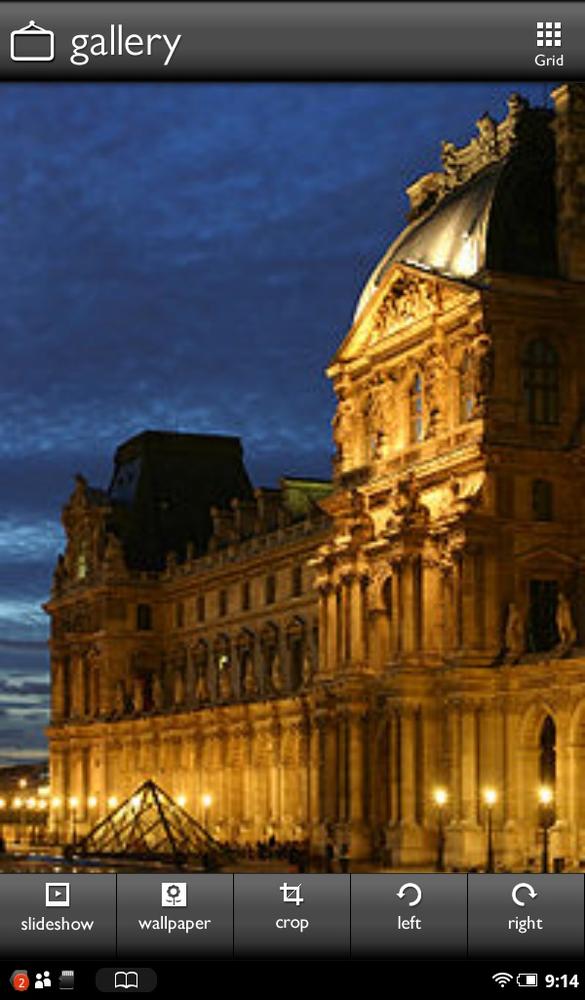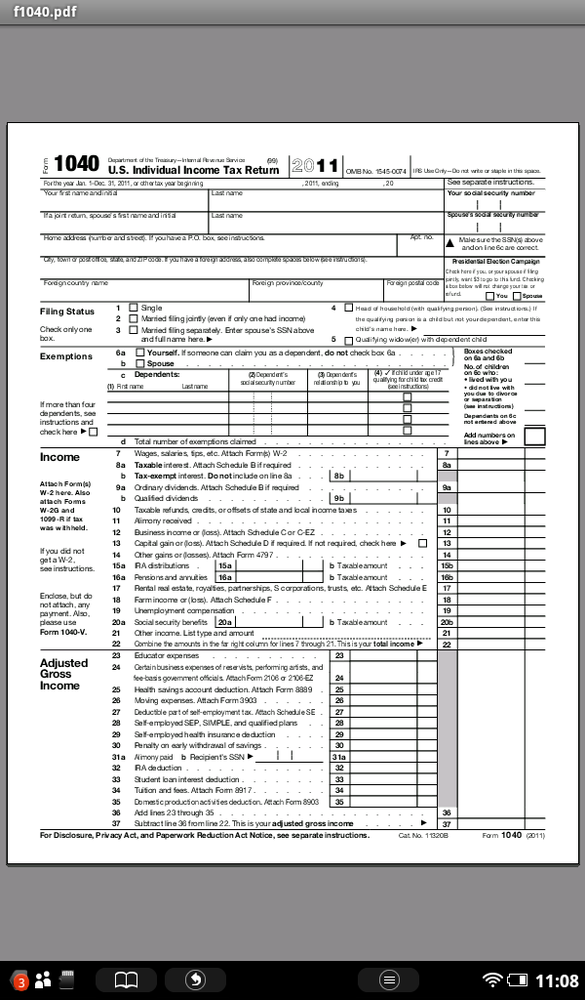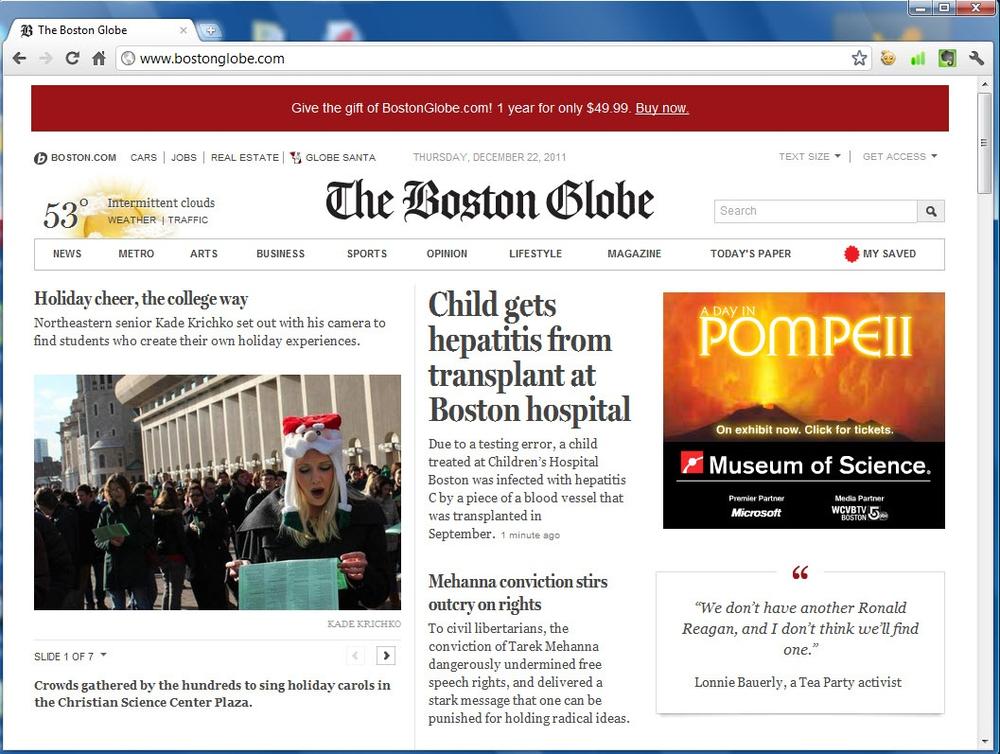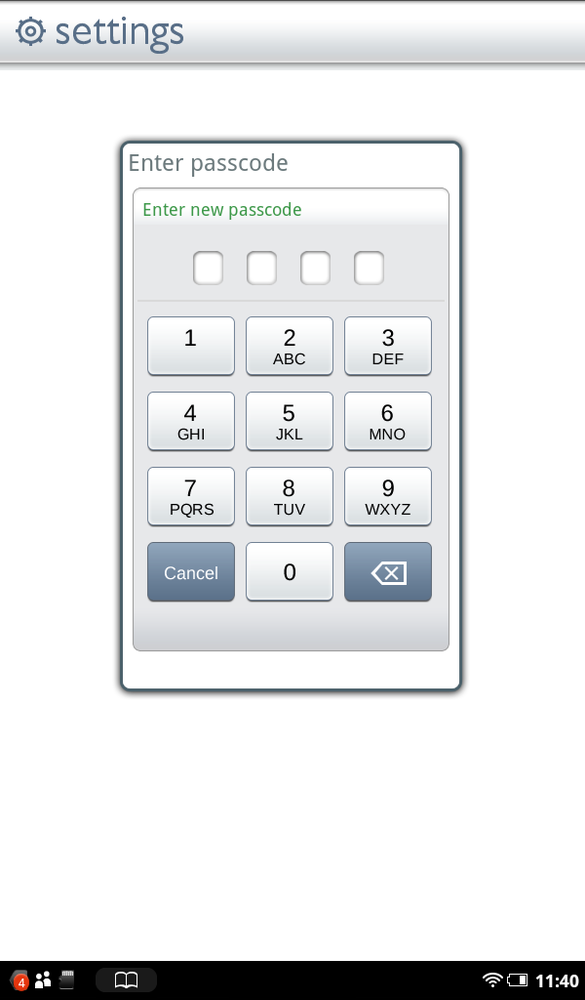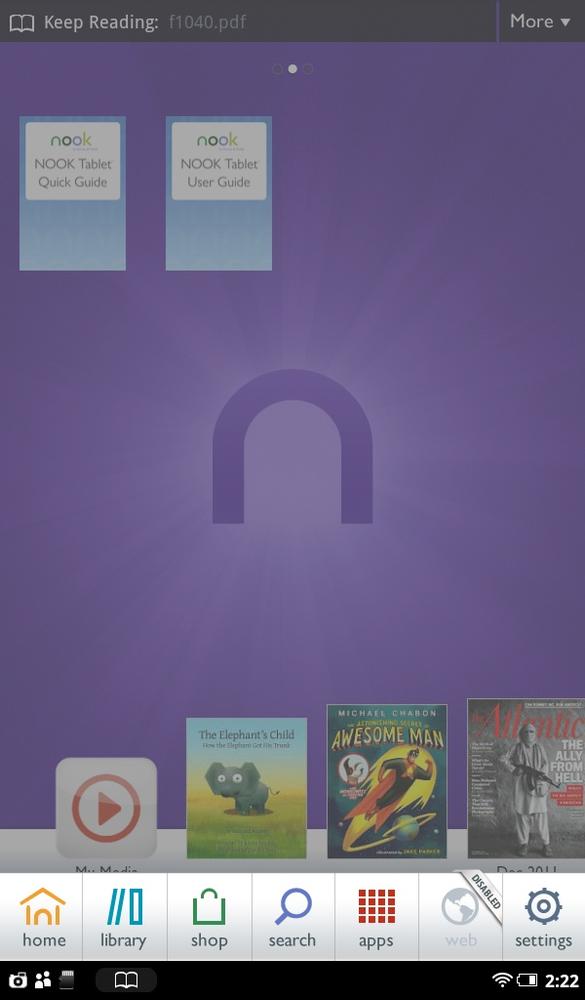THE NOOK TABLET IS more than just the best eReader on the planet. It’s also a pro at browsing the Web, with a great built-in browser. You can do anything on it that you can do with big-boy browsers on your PC or Mac—visit anywhere on the Web, bookmarks web pages, use web forms, and so on. The screen may be smaller than your desktop display, but it’s big enough and clear enough to give you a satisfying web experience wherever you go. How to do it all? That’s what this chapter is for.
To access the Web, press the NOOK button, and choose Web from the Quick Nav bar. The NOOK Tablet’s browser launches.
Note
If the button for the Web is grayed out and sports a Disabled badge, it has been turned off and you can’t browse the Web. Fear not; you can easily turn it back on—turn to Disabling the Browser to learn how.
The NOOK’s browser has plenty of goodies, much like those in a computer browser, including bookmarks, AutoComplete for web addresses, cookies, password memorization, the ability to save pages...just about the whole nine yards. However, the browser itself is fairly barebones, and its simplicity can be off-putting at first. But once you know your way around a bit, you’ll be browsing at warp speed. Here are the main controls you need to know about:
Address bar. Here’s where you enter the URL—the web address—for a page you want to visit.
Bookmarks. Tap this button, and you’ll add the current page to your Bookmarks list and also be able to see pages you’ve visited frequently, and the history of your web browsing. See Bookmarks for more details.
Options menu. Tap this button to the far right of the address bar to get at many of the browser’s features, including going forward, opening a new browser window, seeing and managing your bookmarks, finding text on a page, and more. To see all your open windows, and to close any that you don’t want open anymore, tap Windows. To reload the current web page you’re visiting, tap Refresh. (You may want to refresh the page to see if there’s new content on the page since you first visited, or if the page didn’t load completely and you want to try again.) There’s also a Forward button, and a More button, with plenty more options, as you’ll see in Refreshing Pages, Going Forward, and More.
Back button. Tap here to go to the page you last were on.
The address bar is the box at the top of the browser where you type the URL of the website you want to visit. To type a URL into the address bar, first tap the text box in the bar. The current URL gets highlighted in green. To delete the current URL, tap the X that appears on the right side of the screen. However, when the URL is green, you don’t really need to do that, since when you start typing, the current URL vanishes and is replaced by what you type.
Then use the keyboard to type an address. As you type, the NOOK displays sites you’ve visited that match the letters you type. So when you type the letter C, for example, it might display Computerworld.com, CNN.com, and so on. It may be a very long list.
As you continue to type, the list narrows down and matches only those sites that match the letters you’re typing. So if you type com, cnn.com no longer appears on your list, but computerworld.com does. When you see the site you want to visit, just tap its listing; you head straight there. If there’s no match on the list, you have to type the entire URL. After you type the URL, tap the Go button to the right of the address bar or on the keyboard.
You may find it easier to type URLs if you rotate the NOOK 90 degrees. That way, the keys are much larger, and you’ll be able to see more of the URL as you type. When you type this way, matching sites and terms show up in boxes just above the keyboard, rather than in a list.
Tip
Don’t bother to type the http:// part of a web address. The NOOK knows to put that in for you. You must, however, type the .com or other ending, such as .edu. After you’ve typed the address, tap the Go button to the right of the address bar or on the keyboard, and you head to the page.
You can also use the address bar to search the Web. Just type your search term, but don’t add a .com ending. Your browser searches the Web for the term using Google.
When you head to a page, a small green progress bar appears just above the address bar, showing you how much of the page has been loaded, and indicating how much is left to go. An X also appears in the place of the Bookmark icon. Tap the X if you want to stop loading the page.
Head to a web page, and most of the time you see an entire page, laid out with the same fonts, links, pictures, and so on, as if you were visiting it using a computer with a larger screen. Move around the page by using the normal NOOK gestures. Of course, looking at an entire web page on the NOOK’s screen isn’t the same thing as looking at a web page on a 21-inch monitor. The type and photos are small, and the links can be difficult to tap on. But letting you see the entire screen at once makes a good deal of sense, because at a glance, you can see what section of the page you want to view.
That’s where the fun begins. You can use the NOOK’s zooming and scrolling capabilities to head quickly to the part of the page you want to view, and then zoom in.
You’ve got four ways to do so:
Rotate the NOOK. Turn it 90 degrees to the left or to the right. The NOOK changes the orientation of the website to fill the wider view, and while doing so, zooms in.
Use the two-finger spread. Put two fingers on the NOOK’s screen on the areas where you want to zoom in, and move your fingers apart. The web page stretches and zooms in. The more you spread, the greater the zoom. Pinch your fingers together to zoom back out. You may need to do the two-finger spread or pinch several times until you get the exact magnification you want.
Double-tap. Double-tap with a finger on the section of the page where you want to zoom. Double-tap again to zoom out. You can’t control the zoom level as finely with the double-tap as you can with the two-finger spread.
Use the + and – signs. As you move around the page, two buttons appear on the lower-right portion of the screen, + and –. Tap the + button to zoom in and the – button to zoom out.
Once you’ve zoomed in, scroll around the web page by dragging or flicking your finger—the same kind of navigation you use for other apps on the NOOK.
When it comes to links, the NOOK Tablet’s web browser works largely like any computer browser, except that you tap a link rather than click it. Tap the link, and you get sent to a new web page.
Note
Sometimes when you tap a link, instead of loading a web page, the NOOK may take a different action. For example, if the link is to an email address, it opens the email app, with a new message addressed to the link’s email address.
But this is the NOOK, so there’s a lot more you can do with links than just tapping them. Hold your finger on a link, and a menu appears with these options:
Open. Opens the linked page in the current window.
Open in new window. Opens the linked page in a new window.
Bookmark link. Puts the link into your Bookmarks list.
Copy link URL. Tap to copy the link’s URL to the Clipboard, so you can paste it somewhere else, such as in a document or an email.
Tip
If you hold your finger on a graphic that’s also a link, a “Save image” option appears, which lets you save the graphic. See Saving Online Images for details.
The NOOK Tablet’s browser doesn’t confine you to a single window—you can use multiple ones and easily switch among them. In fact, you may have multiple windows open without even knowing it.
Note
The NOOK Tablet uses Adobe Flash Player, so you can watch the Flash videos you find on websites such as YouTube and many others.
To open a new window, tap the Options menu, and from the menu that appears, tap “New window.” A new window opens, and your old one appears to go away. (Don’t worry; it’s still there, lurking in the background.) When you open a new window, it opens to a Barnes & Noble page welcoming you to the NOOK. You can change that, however; for details, see Most Visited and History Lists. On the new page you’ve just opened, head to the website you want to visit. You’ve now got two web pages open, even though you only see one of them. You can keep opening web pages like this, and have multiple pages open, although you’ll see them one page at a time.
How to switch to another window? Tap the Menu button and tap
windows. You see a list of all the browser windows you have open. Tap
any you want to switch to. To close a window, tap the X button at its
far right. To open a new window, tap the windows icon
![]() at the top of the screen.
at the top of the screen.
Just as with computer-based browsers, the NOOK’s browser lets you save your favorite sites as bookmarks—sites you can easily visit again without having to retype their URLs. In fact, before you even use your browser, it has bookmarks for a few popular sites, including BN.com, Facebook.com, Twitter.com, and YouTube.com, among others.
Whenever you visit a web page you want to add as a bookmark, tap
the Bookmark button ![]() on the right side of the address bar, and the
Bookmark screen appears. You’ll see all your bookmarks, and on the
upper left of the screen you’ll see the page you were on when you tapped
the button, with the word “Add” on it. Tap it and the “Add bookmark”
screen appears, with the name of the page you were on, and its
address.
on the right side of the address bar, and the
Bookmark screen appears. You’ll see all your bookmarks, and on the
upper left of the screen you’ll see the page you were on when you tapped
the button, with the word “Add” on it. Tap it and the “Add bookmark”
screen appears, with the name of the page you were on, and its
address.
Tap OK, or else edit the screen (for example, to change the title). Here you can edit the name or the actual URL of the bookmark. In the Name box, type a different name if you want one, and in the Location box, type a different location. Then tap OK. Or you can just leave it as is and tap OK. The bookmark is added to your list. To go back to the browser, tap the Go Back button.
Note
If you edit the URL, and the new URL differs from the page you wanted to bookmark, you’ll go to the URL you typed in, not the original one you planned to bookmark.
When you’re in the browser, to see the bookmarks, tap the Options Menu and then tap Bookmarks. You see all your bookmarks. To head to any, just tap it and you’re there.
Note
Most of the time when you add bookmarks, and then go to your bookmark screen, you see thumbnails of the pages you’ve added. However, in some instances instead of seeing a thumbnail, you see a generic icon representing a Web site. The bookmarks pre-added to the NOOK all show up with the generic icons until you visit them; after you visit them they generally appear with thumbnails of the websites.
The NOOK Tablet lets you do more than just go to bookmarks. You can delete them, edit them, and more. To do it, head to the Bookmarks screen and then hold your finger on the bookmark you want to edit or manage. A menu appears with the following choices:
Open. Opens the bookmarked site in the current window. So let’s say you’re on www.google.com, you go to your bookmarks, and then hold your finger on the www.bn.com bookmark. Now, www.bn.com opens in the window where www.google.com had previously been open.
Open in new window. Opens the bookmarked site in a new window. So if you’re at www.google.com, open your bookmarks, and then hold your finger on www.bn.com, www.bn.com opens in a window of its own.
Edit bookmark. Brings up a page that lets you edit the name and location of the bookmark. It’s the same page for adding a bookmark.
Note
If you sometimes find yourself with a slow WiFi Internet connection and wish there was a way to browse the Web faster, here’s a bookmark you should add to your list: http://google.com/gwt/n. It hides most graphics and lets you browse the Web much more quickly on a slow connection.
Delete bookmark. Deletes the bookmark. After you tap it, you get a warning that you’re about to delete the bookmark, just in case you want to reconsider, or if you tapped this option by accident.
Set as homepage. Tap this, and from now on whenever you open a new window, it opens to that site.
When you go to your Bookmarks, you see two more ways to browse sites that you’ve been to before—“Most visited” and History. The NOOK Tablet keeps track of sites you’ve visited, and puts these two lists together based on that. They’re great ways, in addition to Bookmarks, to head back to sites you’ve visited before without having to type—or even remember—the web addresses. The “Most visited” list shows the sites you’ve visited most often, with the most visited sites at the top. The History list shows all the sites you’ve visited, in the order you’ve visited them—today, yesterday, and so on. Just tap the corresponding tab to see the list.
The lists are scrollable, so flick through them to see more lists off the bottom of the screen.
The “Most visited” list works much like the Bookmarks list—tap the site you want to visit and you immediately get sent there. You’ll notice one difference between these lists and the Bookmarks list: The sites all have stars to the right of them, some gold, some gray. A gold star indicates that the site is on your Bookmarks list. Tapping a gray star adds that site to your Bookmarks (and turns the star gold). To remove a site from your Bookmarks list, tap a gold star. It turns gray, and the site gets removed from your Bookmarks list. Whenever you add or remove a site from your Bookmarks list in this way, you’ll get a brief onscreen notification.
Just as with Bookmarks, you can edit and manage the “Most visited” list. Hold your finger on the site you want to edit or manage, and a menu appears, similar to the one you see when you hold your finger on a site in Bookmarks.
The lists are nearly identical, with a few minor differences:
Add bookmark is included in the “Most visited” menu so you can add the site to Bookmarks. It’s easier to simply tap the gray button to do this, but if you like your NOOK so much that you enjoy holding your finger on it, you can do it this way as well.
Remove from history removes a site from the “Most visited” list as well as from your History list.
Note
If you press and hold a site in your “Most visited” list that’s in your Bookmarks list, you’ll have the option of removing it from Bookmarks as well.
If you want to clear out your entire “Most visited” list and History list, tap “Clear history” at the bottom of the screen.
The history list is organized slightly differently from the other two lists—you can see the sites you’ve visited in groups—Today, Yesterday, Last Seven Days, Last Month, and so on. Tap the button next any of the groups, and the group expands so you can see all the pages you visited today, for example. Tap it again and the list collapses.
As with the “Most visited” list, tap a star next to a site to add it to your Bookmarks, and the star turns gold. Tap a gold star to remove it from your Bookmarks, and the star turns gray. Tap any site to get the same set of options that you do when you hold your finger on the site in the “Most visited” list. You can also clear your history by tapping the “Clear history” button at the bottom of the screen.
When you browse the Web, you may be on a mission of sorts—looking for a specific piece of information. You might be looking for a specific word or phrase within a web page. And when you’re on a page, you may be looking for more information about it. The NOOK browser can do all that and then some. To do it all, press your finger somewhere on the web page that’s not a graphic or link. A menu appears with these options:
Find on page. Looking for text on a page? Tap this option, and a search box appears, along with the keyboard. Type the text or phrase you’re searching for, and the NOOK finds the text, sends you to its location on the page, and highlights it in green. To find the next time the text or phrase is mentioned, tap the right arrow. To find a previous mention of it on the page, tap the left arrow. To exit the search, tap the X to the right of the search box.
Note
The original version of the NOOK Color software gave you an additional option—the ability to copy text to the NOOK Clipboard. But when the NOOK Color software was updated in late 2011 and early 2012, that feature was taken away. The NOOK Tablet never had the feature. However, it’s possible that a software upgrade may make it available again.
Page info. Tap to see basic information about the page—title and web address. Tap Back to make the window disappear.
Settings. Here’s how you can change countless browser settings, including the size of the text displayed, privacy controls, and so on. See Online Privacy and Security for details.
Downloads. As explained in Browsing and Managing Files on your NOOK Tablet, this will bring you to the folder that has all your downloaded files.
Bookmark this page. Tap this option and then add the bookmark in the usual way (Bookmarks).
Two things appear to be missing on the NOOK Tablet’s browser that you’ll find on a computer’s browser—Forward and Refresh buttons. You may not see them, but there’s a simple way to go forward or to refresh a web page. Tap the Options menu, and then select Refresh to refresh the page, or Forward to go forward. That’s all there is to it.
There are other things you can do when you tap the Options menu, covered elsewhere in this chapter: Head to bookmarks (Bookmarks), and see and manage your open windows (Multiple Windows). And if you tap More Options, you’ll be able to do even more: Add a bookmark, find text on a page, get page info, view your downloads (all in Tip), and adjust your settings (Online Privacy and Security).
When you’re browsing the Web, sooner or later you’ll come across a picture you’d like to save. For example, if a friend posts a picture from your birthday party on Facebook, you can save it on your NOOK Tablet and then share it with others.
There’s a quick and easy way to save that image. Hold your finger on the picture for a second or two, and a menu appears with the following options:
Save image. Downloads the picture to your NOOK. See the next section to learn how to go back and view all the pictures in this folder.
View image. Opens the image in its own page. As a practical matter, this option doesn’t do much, because it doesn’t make the image any larger or smaller—you’re seeing the same image, just on its own rather than on a web page.
Note
If the picture is also a link, the menu shows the usual options for bookmarking the link, saving the link, and so on.
When you download an image, you’ll get a brief alert that the file is downloading. A small multiheaded arrow will appear in the Notification bar, indicating that a file is downloading. (If the graphic is very small, it may download so quickly that you don’t notice the arrow.)
After you’ve downloaded a picture, tap the Notification bar. You’ll see a notification with the name of the file you just downloaded and the time it was downloaded. Tap it and you’ll open the file in the Gallery. For details about what you can do with a picture once it’s in the Gallery, see Using the My Media App for Viewing Photos and Playing Video.
What if you don’t want to see the picture right away, or want to see pictures you’ve previously downloaded? In the browser, tap the Options Menu and select More Options→Downloads.
You come to a list of all your pictures. They’re listed by file name, which may or may not give you a clue to their contents. If you see something like Serena_Williams.jpg, you’ll know it’s a photo of the tennis great Serena Williams. But if you see something like Wi231qil.jpg, you won’t have a clue what it is.
Underneath the name, you’ll find the address of the site you downloaded it from, along with the file size and, to the right, the date of download. Tap any picture to view it in the Gallery.
Tip
When you download a picture from the Web, it gets downloaded to the NOOK’s My Files→My Downloads folder on the NOOK’s internal storage. You can head there outside of your browser. In the Library, tap “My stuff”→My Files. Then tap My Files→My Downloads. You’ll see a list of all the files you’ve downloaded. Tap any to open it in the Gallery. (If you haven’t yet downloaded any files from the Web, the My Downloads folder won’t show up.) You can also see the pictures there by connecting your NOOK to a PC or a Mac, and then browsing to My Files→My Downloads folder on the NOOK.
If you’d like to get rid of the downloaded files, tap the Clear List button at the bottom of the page. You’ll get a warning telling you that you’re about to clear the list and remove all the files from the browser cache (Cookies). In plain English, that means that you’re about to delete all the files. So tap OK only if you really want to kill them all.
What if you want to delete some files, but not all of them? In your Library, tap “My stuff”→My Files. Then tap My Files→My Downloads. You’ll see a list of all your downloaded files. Hold your finger on any you want to delete, and select Delete from the menu that appears. You may first want to open the file in the Gallery by tapping it, to make sure it’s the file you want to delete. You can also delete the files by connecting your NOOK to your PC or Mac, and then using Windows Explorer on your PC or Finder on your Mac to delete the files. See Browsing and Managing Files on your NOOK Tablet for details.
The Web is filled with PDF files, documents that often have complex layouts combined with graphics. These files can’t be read directly by your browser. It’s easy to read them on your NOOK, though. When you tap a link to a PDF file, it gets downloaded in the same way that a picture does, and you view it the same way as well. So just follow the instructions for viewing pictures, and look, instead, for the PDF file you downloaded. Then tap it, and it opens in Quickoffice, an app that ships with your NOOK and that lets you read PDF files in addition to Microsoft Office documents such as Word, Excel, and PowerPoint files.
As you browse the Web, you may come across sites that differ significantly when viewed on the NOOK Tablet compared with the exact same sites viewed on a computer. That’s because web designers have created pages specifically designed to be viewed with mobile devices such as the NOOK and smartphones, taking into account that mobile devices have smaller screens than computer screens.
ABC News for example, has sites designed especially for mobile viewing. Head to the same site at the exact same time of day with a smartphone and a computer, and you see very different pages, even though the content of the pages is the same.
These pages are formatted to be read on the phone, so very often they don’t include complex layouts, and instead present articles and other information in scrollable lists. They generally don’t let you zoom in and zoom out. You’ll navigate primarily by scrolling and clicking links.
The websites know which kind of page to display by detecting what kind of device you’re using. Sometimes, though, the websites get confused, and so you may visit the website one day and get delivered a page designed for a mobile device, and another day and get one designed for a large computer monitor.
Odder still, sometimes the type of page switches depending upon the orientation of your NOOK Tablet. Visit a page when you’re in the vertical orientation, and it displays the page for a mobile device; turn the NOOK horizontally to landscape mode and the page displays for a full-blown computer monitor. Turn it back to vertical, and it switches to the mobile site again.
Tip
There are a few things you can try if you come across a page that displays for a mobile device that doesn’t look good on your NOOK. Try changing the orientation; sometimes that works. You may also want to look around the page to see whether there’s a link you can click that will let you display the full version of a page, rather than the mobile version. The techie news site Techdirt.com, for example, includes a link like that.
Whether you browse the Web with a computer or with your NOOK Tablet, there are potential security and privacy dangers out there—cookies, pop-ups, and malicious websites. The NOOK browser, just like its big—brother browsers on computers, includes the tools you need to keep you safe and protect your privacy when you browse the Web.
You get at all the privacy and security settings via the browser’s Settings menu. When you’re in the browser, tap the Options Menu and choose More Options→Settings, and then scroll down to the Privacy Settings and Security Settings areas to get at the most important settings.
Out of the box, the NOOK’s privacy and security settings are configured to make sure that you’re safe and secure. So most likely, you won’t need to change any settings. But there are a few options and features you might want to know more about, or that can be used to enhance your privacy, as you’ll see in the next sections.
Cookies are tiny bits of information that some websites store on the NOOK Tablet for future use. When you register for a website and create a user name and password, the website can store that information in a cookie so you don’t have to retype it every time. Cookies can also remember your habits and preferences when you use a website—your favorite shipping method, or what kinds of news articles you’re likely to read.
But not all cookies are innocuous, since they can also track your web browsing from multiple sites and potentially invade your privacy.
The NOOK browser gives you control over how you handle cookies—you can either accept them or tell the browser to reject them. Keep in mind that if you don’t allow cookies on your NOOK, you may not be able to take advantage of the features on many sites.
To bar websites from putting cookies on your NOOK in the Privacy Settings section of Settings, uncheck the box next to “Accept cookies.” The checkmark disappears, and from now on, no cookies will be put on your NOOK. You can always turn this setting back on again, if it causes problems with web browsing.
While you’re in Privacy Settings, you can also delete all the cookies that have been put on your NOOK so far. Tap “Clear all cookie data.” You get a warning that you’re about to delete your cookies. Tap OK to clear them, or Cancel if you change your mind.
There’s more you can do in the Privacy section of the browser’s settings screen to make sure your privacy isn’t invaded. For example, you can clear your browsing history so that others who use the browser can’t see where you’ve been.
You can also tap “Clear cache” to clean out website information your browser has stored on your NOOK Tablet. A cache is information the browser stores on your NOOK so it won’t have to get that information from the Web the next time you visit that site. The cache speeds up browsing, since it’s faster to grab the information—a website image, for example—from your NOOK than from the Web. Tap “Clear cache” if you want to clear all that information out, if you worry that the information there poses a privacy risk.
At many websites, you log in by typing a user name and password, and other information such as your address. The NOOK browser remembers those user names, passwords, and other information, and fills them in for you automatically when you next visit. That’s convenient, but it also presents a privacy risk, because someone else using your NOOK Tablet can log in as you.
If that concerns you, there are two actions you can take. First, in the Privacy section, tap the green checkmark next to “Remember form data.” When you turn it off, the browser won’t remember user names, passwords, and other information you type into forms. You can always turn it on again. To delete all the information already stored on your NOOK, tap “Clear form data.” Next, scroll down to the Security Settings area and turn off the checkbox next to “Remember passwords.” To clear out saved passwords, tap “Clear passwords.”
What’s top on your list of web annoyances? Most likely at the pinnacle are pop-ups and pop-unders—ugly little windows and ads that either take an in-your-face stance by popping up over your browser so that you have to pay attention, or pop under your browser so that you don’t notice they’re there until you close the browser window.
Sometimes these pop-ups and pop-unders are malicious, and if you tap them they attempt to install dangerous software or send you to a malicious website. Sometimes they’re merely annoying ads. Sometimes, though, they may actually be useful, like a pop-up that shows a seating chart when you’re visiting a ticket-buying site. The NOOK browser includes a pop-up blocker, and like all pop-up blockers it can’t necessarily distinguish between bad pop-ups and pop-unders and good ones, so it blocks them all.
However, if you’re on a website that uses pop-ups that you want to see, you can turn off the pop-up blocker. Head to the Page Content section of the browser settings, and tap the green checkbox next to “Block pop-up windows.” When you leave the site and want pop-ups blocked again, go back to the setting and tap it to turn it on. The green checkmark will reappear next to the setting, and you’ll be protected.
There are plenty of other things you can do on the settings page, many of which are too esoteric to bother with. Right out of the box, the NOOK Tablet has been configured very well.
However, there are a few settings worth paying attention to in the Page Content settings:
Text size. Tap here, and choose from five different sizes you want to show on web pages. The choices are somewhat inexact, and range from Tiny to Huge. (Out of the box, the choice is Normal.) Generally bigger is better than smaller, because many web pages were designed with larger monitors in mind than the 7-inch screen of the NOOK.
Browser mode. As explained in Web Pages Designed for Mobile Devices, some websites check when people visit them to see what kind of device or computer they’re using—a full-sized computer, or a smaller mobile device like a tablet or a smartphone. When you visit a website with your NOOK, the site assumes you’re using a tablet, and so when possible displays a page suitable for displaying on the tablet. (At least, that’s what happens in theory. In practice, websites tend to show the NOOK pages designed for computer monitors, not tablets.) If you’d like to always see the full-blown computer monitor page, you can trick websites into thinking you’re using a monitor. Tap Browser Mode and turn on Desktop Browser Mode. Come back here again to change to Tablet Browser Mode if you find it problematic.
Set home page. Tap here, and a screen appears into which you can type the address of any page you want to be your home page. If you’re currently visiting a web page, tap “Use current page” and that page becomes your new home page.
If you worry that your child may use the NOOK Tablet’s browser to visit inappropriate sites, you’ll be pleased to know that there’s an easy way to disable the browser so only those who know the password can use it. It’s easy to turn back on—but only if you know the password. Here’s how to disable the browser:
Note
When your browser is disabled, in addition to being unable to surf the Web, you can’t use the Look Up feature in Reading Tools to search for terms using Google and Wikipedia. You also can’t watch the tutorial videos that come with the NOOK. And finally, you can’t search the Web with the search tool in the Quick Nav bar. All of these features depend on the browser.
Press the NOOK button to open the Quick Nav bar, and then tap Settings→Security→Restrictions.
Tap Restrictions, and from the screen that appears, type in a passcode that will be used to disable and enable the browser. Tap four numbers for your passcode. Tap them in again when you’re asked to confirm.
From the screen that appears, tap Browser to turn on the checkbox (turn it green). The browser is now disabled. On the Quick Nav bar or anywhere else the Web icon appears, it will be grayed out, with a Disabled badge. When you tap it, nothing happens.
Note
Disabling the browser turns off the browser, but it doesn’t disable Internet access. So you can still search for and download apps and books, send and receive email, and share recommendations via Facebook and Twitter.
To enable the browser again, in the Quick Nav bar, tap Settings→Security→Restrictions. Enter your passcode, and then uncheck the green box next to Browser to enable the browser again.
